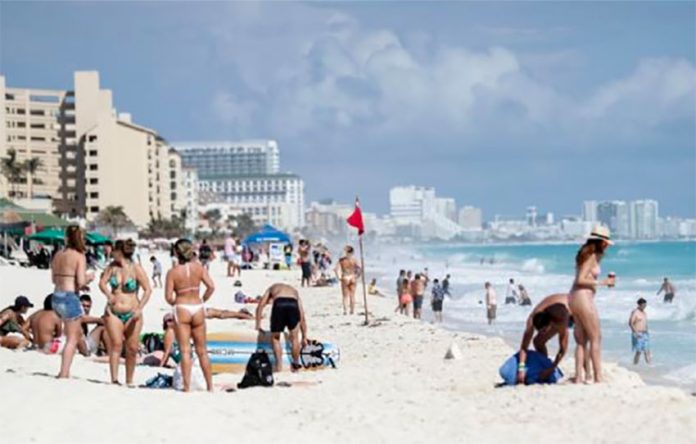Coronavirus cases surged on Mexico’s Caribbean coast in January and early February after large numbers of tourists descended on beach destinations over the Christmas-New Year vacation period, forcing authorities to implement tighter restrictions across Quintana Roo as of Monday.
Between the start of January and February 5, the state of Quintana Roo, home to popular destinations such as Cancún, Playa del Carmen and Tulum, recorded 3,176 confirmed cases of the virus, according to local health authorities.
Not since the middle of last year, when 3,114 confirmed cases were recorded between June 15 and July 15, had Quintana Roo seen so many cases in such a short period of time.
State authorities attribute the upsurge in new infections to the influx of domestic and international tourists in December – more than 400 flights per day were arriving at and departing from the Cancún airport in late 2020 – as well as end-of-year gatherings of family and friends, large clandestine parties and events and people relaxing their observance of health rules such as keeping one’s distance from others and wearing a mask.
The arrival of international visitors, many of whom came from the virus-ravaged United States, brought much-needed revenue to Quintana Roo, whose economy relies heavily on tourist dollars, but bequeathed an unwanted legacy: tighter restrictions that will cause more economic pain for the state’s residents.
Governor Carlos Joaquín González announced Sunday that all of Quintana Roo would be high risk orange on the state coronavirus stoplight map as of Monday. The northern part of the state, where Quintana Roo’s main tourism destinations are located, switched to orange from medium risk yellow in the last week of January and now the southern half is also painted that color.
(The state has been orange on the federal map since mid-January but the Quintana Roo government has its own stoplight system that it uses to guide the easing and tightening of economic restrictions.)
Businesses across the state will now have to respect shorter opening hours while a 30% maximum capacity level for beaches, parks, cinemas, theaters, shopping centers, casinos, hair salons, factories and places of worship applies equally in Cancún in the north and Chetumal in the south as well as in all other cities and towns.
Hotels, restaurants, archaeological sites, theme parks, golf courses, gyms and sports centers can operate at a higher maximum capacity of 50% while the orange light designation remains in place but bars and nightclubs in all 11 municipalities must remain closed.
The state’s schools, like those across the country, are still shut almost a year after they closed at the onset of Mexico’s coronavirus outbreak.

Quintana Roo has recorded 19,286 confirmed cases of coronavirus since the start of the pandemic, and almost half the cases were detected in Benito Juárez, the municipality that includes Cancún.
Othón P. Blanco, which includes state capital Chetumal, ranks second for cases followed by the municipality of Solidaridad, where Playa del Carmen is located.
Hospital occupancy in Quintana Roo is currently 26% for general care beds and 24% for beds with ventilators, according to federal data.
The occupancy rate is slightly higher in the north while there are more active coronavirus cases in the south, Governor Joaquín said Sunday, adding that authorities will ramp up Covid-19 testing as a result of the statewide orange light designation.
The health care facility that has come under more pressure than any other in Quintana Roo during the pandemic is the Cancún General Hospital, where 47% of general care beds are currently taken.
“We’re stressed because my colleagues on the front line against Covid are fatigued, … there have been increases [in hospitalizations], new admissions to the hospital,” a nursing director told the news agency EFE.
Identified only as Luis Alberto, the nursing chief said that coronavirus patients’ medical reports indicated that they recently relaxed observance of health measures and traveled to different parts of Quintana Roo and/or gathered with friends and family.
He said there has been a recent increase in admissions of younger Covid-19 patients and called on the public not to let their guard down and continue to follow the measures designed to slow the spread of the coronavirus.
“It sounds disturbing to say it but sometimes it’s not until those dying are people we know that we understand the gravity of the situation,” Luis Albero added.
More than 2,200 people have lost their lives to Covid-19 in Quintana Roo, according to official data, including more than 200 since the start of 2021.
In recording an increase in case numbers in January, the Caribbean coast state suffered the same fate as Guerrero, where coronavirus restrictions were also eased in tourist destinations for the end-of-year vacation period. That state switched to maximum risk red on the stoplight map in late January amid what the governor described as “the worst moment of the pandemic.”
There are currently 13 red light maximum risk states on the federal stoplight map, which will be updated at the end of this week.
Meanwhile, Mexico’s accumulated case tally rose to 1.93 million on Sunday with 6,065 new cases reported while the official Covid-19 death toll increased by 414 to 166,200.
Source: EFE (sp), El Economista (sp)
